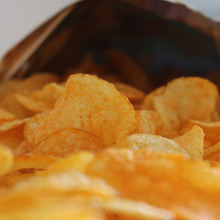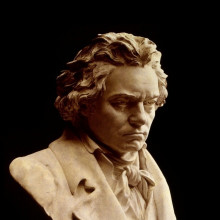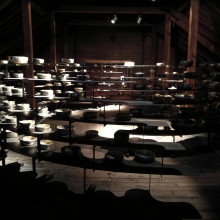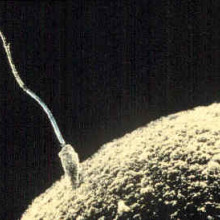Scroll Over Beethoven: Machines Making Music
It’s Beethoven’s 250th birthday! What today’s tech tells us about his music? And have computers become powerful enough to take the same creative steps as he once did? Plus, in the news: the practical challenges behind the largest mass vaccination campaign in history; cutting carbon from crisps; and why have pandas been rolling in poo?
In this episode

01:01 - COVID vaccine rollout: who's getting what?
COVID vaccine rollout: who's getting what?
Michael Head, University of Southampton
There's been much to celebrate. 90 year old Margaret Keenan has become the first person in the world outside of a clinical trial to receive Pfizer’s COVID-19 vaccine. But this is merely the start of a long journey to get these vaccines to millions of people across the UK, and then billions around the world. What's the plan, and which vaccines will go where? Michael Head is a Senior Research Fellow in Global Health at the University of Southampton, and answered these questions for Chris Smith…
Michael - Well, this is a wonderful day for science. It's a wonderful day for research and it's a wonderful day for the UK National Health Service. But of course, this is very much just a starting point. We need to vaccinate the entire country and we need to vaccinate the entire world as much as we possibly can. So there is still a lot of work to do from here, but this is an excellent start.
Chris - Indeed. I think Andrew Pollard from the Oxford vaccine group described it as analogous to being at Everest base camp.
Michael - Absolutely. So we've dragged ourselves up a little bit of the mountain. We've cleared some rather forbidding looking cliffs at the bottom of it, but the peak is still away in the cloud at the very top. So there is a long way to go: 16 billion doses of a vaccine to cover the entire planet.
Chris - Talk us through then what really we've got to do here in the UK to begin our ascent of the peak.
Michael - So we are starting with healthcare workers, care workers, and very soon in the next week or two vaccinations will be taken into care homes. There's then other older populations and people who are particularly clinically vulnerable. Beyond that, it will be rolled out to the rest of the population.
Chris - Do we have any plans or clear guidance yet as to how they intend to do this? Because we've got a vaccine here that needs to be kept at minus 70 degrees until about the last five days, during which you intend to use it. It comes in batches of 975 doses, which means you've got to basically have a queue with that number of people in it to avoid wasting any vaccine. These are quite a lot of constraints.
Michael - Absolutely. So the initial plan was that care home residents would be in the very first wave of vaccinations, but due to these logistical constraints around the minus 70 degrees storage, that's been postponed for a week or so whilst the fine tuning of the logistics are being worked out. The Pfizer candidate, wonderful though it is, does come with extra challenges that some of the other vaccine candidates don't.
Chris - Well, you've brought up the question of other vaccine candidates. Can we talk now about the AstraZeneca offering? They have published a paper in The Lancet this week in which they give some of the data from their phase III trial. Is there anything in there which we need to be aware of?
Michael - So the findings that were published in The Lancet today reflect what was mentioned in the press release about three weeks back. So there's no real surprises. So we can see, for example, that the average effectiveness is around 60 something percent. But if you take the - as it turns out - accidental small dose, and then scale up to a full second dose, that raises the effectiveness to about 90%. The problem we have is there's not too much data about these doses in the elderly, the older populations. And the accidental dose there again, there's not too many people who were given that dose. So it certainly looks very, very promising. And I think we probably will see it approved at some point. Maybe pre-Christmas, if not very early in the new year.
Chris - What appears to have happened is, according to AstraZeneca, a subgroup of people in their trial got a smaller dose than they should have done when they were first given the vaccine. And then they got the full dose next. Why should there be a better response, a 90% outcome instead of a 60% outcome in terms of protection, when you do it like that?
Michael - Well it's a very intriguing finding. And I think we're still waiting to really find out why. The theory is that the first, smaller dose primes the immune system, and then you get a much better, stronger response when you add the second dose. It remains to be seen precisely what immunological curiosities are going on there. But that's the theory right now, as far as I understand it.
Chris - The problem, as I see it, is that people will see the Pfizer data and it says, "this is 95% effective" or so we presume. And they'll see the AstraZeneca data and it might be as low as 60%. For a vaccine that's still pretty good, isn't it? But people will say, "well, hang on that doesn't look as good as the other one. So I want the Pfizer one". Is this going to create a problem, a two tier system, perhaps? A postcode lottery even, for who gets what? And therefore could that lead to problems?
Michael - There may be some tensions. So I think we do need to be prepared for that. I think what people are probably hoping is that the 90% effectiveness as referred to in the Lancet paper for that small dose followed by full dose from the Oxford candidates, people are probably hoping that that comes to the fore. And is the answer in terms of, "what effectiveness is the Oxford candidate?".
Chris - The other question, which is coming up quite a lot, is this uncertainty around whether or not someone who has been vaccinated can still nevertheless, catch the virus. Now, why is that uncertainty arisen? Why are people who are vaccinated not completely protected? And is this just a theoretical risk? Or do you think actually there probably is something in this?
Michael - So with the Oxford AstraZeneca candidate, they've been testing their study participants weekly. So we can look at asymptomatic transmission. So although the vaccine protects you from getting ill, it may not protect you from getting infected and theoretically being able to pass it on, which is what we think may be happening with the Pfizer vaccine. It prevents you from getting ill, rather than preventing you from getting infected.

07:06 - Why pandas roll in poo in winter
Why pandas roll in poo in winter
Claudia Wascher, Anglia Ruskin University
Scientists have reported seeing some unusual giant panda behaviour: some of the creatures appear to have a penchant for rolling in fresh horse manure in winter. The theory is that the muck contains chemicals that deaden the panda’s ability to feel the cold. Katie Haylor explains...
Katie - Using infrared cameras to observe a year of giant pandas in the wild, scientists in China have documented around 40 incidences of these bears sniffing, wallowing in and rubbing horse manure - yep, horse manure - all over themselves, particularly in the colder months. So to reflect on this rather - at least to my ears - unusual finding, I spoke to Anglia Ruskin behavioural biologist Claudia Wascher.
Claudia - It is quite unusual to actually see a species rolling in the faeces of another animal. Individuals avoid going close to faeces because potentially these materials can have parasites, which animals can get affected with, or bacteria. So yeah, it is quite unusual.
Katie - Now I'm no panda expert, but I wouldn't have thought they spend that much time around horses. But it seems the ancient trading routes that cross the bears' habitats have brought these animals in close proximity. And timing is important here because it seems the fresher the faeces, the better.
Claudia - So they have compared how often does this behaviour occur when there is fresh manure compared to all older ones, and it is most frequent in the first couple of days.
Katie - Lovely. So why on earth are pandas giving themselves a horse poo spa treatment?
Claudia - They think that there is a specific chemical component in the horse faeces which is an adaptation to cold. So basically rubbing in the horse faeces would then make the pandas feel less cold.
Katie - In addition to that beautiful monochromatic fur the theory is that pandas are cleverly seeking out additional ways of staving off the chill at colder times of the year, mostly in November through to April.
Claudia - Don't think about it like having another coat on or having a pullover on. But it is more of a reaction. Similar to if you would eat a hot pepper, you would feel warm because there are certain chemicals in the food, which cause a chemical reaction, which causes the sensation in your body. And this is a similar case.
Katie - Claudia is talking about beta caryophyllene, or caryophyllene oxide. Chemical analysis showed that they're particularly prevalent in fresh horse manure. And tests with giant pandas at Beijing zoo suggested that they seem to prefer hay with these chemicals on, compared to controls. And because this poo rolling seemed to be temperature dependent, the scientists wondered if these chemicals could have a role in how animals sense temperature.
Claudia - They have chemically extracted this component from the horse faeces and have then injected mice either with this chemical component, or with a saline solution. And then they have looked in the mice, what kind of behaviours they display in response to cold. And the mice showed more behaviours which are expected as an adaptation to cold; so more shaking behaviours with the controlled substance. And this hints towards that the mice injected with this chemical component would feel less cold.
Katie - So what are these chemicals getting up to? The authors did some laboratory work to delve into this question. And I asked Claudia to summarise this.
Claudia - This chemical component actually responds to a specific channel within the nervous system. What basically happens is that the sensation of cold is a specific sensation, which means that certain parts of the body respond to a certain environmental condition. So nerve cells in the skin, activation in these nerve cells would cause us feeling cold. These nerve cells are inhibited by this chemical component.
Katie - So the authors reckon that on a molecular level, these chemicals are blocking receptors involved in cold sensation. Fair play to giant pandas! It seems rather clever to make the most of the surrounding environment like this. Others are less convinced. In the Science journal magazine this week, the University of Glasgow's Malcolm Kennedy points out that perhaps the pandas are just curious about this horse manure. And that if this lack of feeling chilly were to stop pandas seeking shelter against the cold, this could be highly problematic. Turns out that rubbing stuff all over oneself is not without precedent and the animal kingdom.
Claudia - There's a whole group of self anointing behaviours where vertebrates or different groups of animals rub themselves in some sort of biological substance. Faeces of other species, soil materials, plant materials. They are usually very poorly investigated. This is one of the first studies like this, which I'm also seeing opens up a lot of avenues for future research.

14:03 - Human stuff now outweighs all living things
Human stuff now outweighs all living things
Jan Zalasiewicz, University of Leicester
Humanity has crossed an environmental milestone: the total amount of manmade materials has, this year, passed the point where it outweighs all life on Earth. This comes from a calculation by scientists at the Weizmann Institute in Israel, comparing the total dry biomass on the planet to all human-made constructions and materials. It reinforces the idea that we’re living in a new era - known as the Anthropocene - defined by our own changes to the planet. Jan Zalasiewicz is a geologist at the University of Leicester and took a look at the study - which came out in the journal Nature - for Chris Smith...
Jan - It's a very big number: it's a little bit over a trillion tons. Both all the stuff we've made, and also it's the weight of all life on Earth.
Chris - How did they arrive at these figures though? And how accurate are they? How do you go about weighing all of the life on Earth, and then weighing all the stuff we've made?
Jan - They're both sets of estimates; now they're estimates made as rigorously and honestly as possible. Let's say of all the life on Earth... that includes forests, which one can observe by satellite, measure, and the biologists get some idea of how many trees there are, let's say for a square kilometre of ground, and factor that in. There are more calculations: all the fish in the sea, all the bacteria in the soil, all the bacteria in the rocks beneath the soil. Now there are error bars on all of those figures, but taken together, the figures are a reasonable picture. And a very large proportion of the living weight are forests; they make up probably something of the order of 90%.
For the other measurements, the stuff we make, there are statistics around collected by government institutes, government surveys, industrial bodies; on things like the metals we pull out of the ground, the limestone and mud that we pull out of the ground to make cement, which goes into concrete. There are people who collect materials on industrial production. So this team has taken all of those diverse statistics and put them together to arrive at a headline global figure; not just one figure for today, but they've calculated back to the beginning of the 20th century. And one of the extraordinary things they've shown is just how, particularly since the mid-twentieth century, the amount of stuff we made has gone up and up. It's been doubling about every 20 years.
Chris - I was going to ask you how fast it was changing, because obviously the rate of change is the key thing. So that means literally by as soon as 2040, instead of there being 1 trillion tons of human-made stuff, there's going to be 2 trillion tons of human-made stuff. Now you were part of another study, historically, that's actually called the Technosphere study. That was in 2016, wasn't it? And that study attempted to put a weight, or a mass on all the stuff we've moved around on the Earth surface. That was a lot bigger; the results from that study suggested we've scraped up 30 trillion tons of sea floor, made that much concrete, metal, manufactured things and so on. So what's the distinction between that study and this one?
Jan - That's right. We were comparing two different aspects of the way we've changed the Earth. This present study is simply things we've made, but to make those things, you also need to get materials out of the ground. And also when we build things, we landscape the ground. To grow our food, we need to shift soil around. We scrape the sea floor too, when we trawl for fish and so on. So I think the difference between the two studies shows just much we waste, in the course of making all of the stuff we make, all of our constructions.
Chris - What are the take home messages in this? The fact that we can now say the things we've made outweigh all life on this planet? Is the intention of doing this study to make that poignant, very poignant point that we now need to watch this planet over which we have stewardship, because we're making a very serious dent in it?
Jan - Indeed. It's to give us a sense of the scale of what we're doing, which I think we lacked before. And of course there's a price for everything: there's a price in terms of pollution, in terms of the loss of biological species, in terms of global warming, global heating, perhaps of climate change.

18:44 - A greener crisp: new fertiliser to cut CO2 by 70%
A greener crisp: new fertiliser to cut CO2 by 70%
Peter Hammond, CCm
How much carbon is in the humble crisp? If you take into account the carbon footprint for growing the actual potatoes, it’s a reasonable amount. Nevertheless, it could soon be 70% lower! That’s because crisp-makers “Walkers” have adopted a new chemical process that recycles waste carbon dioxide and potato skins and turns them into fertiliser. Developers CCm are intending - initially - to capture carbon dioxide from a nearby brewery while they set everything up at the crisp factory, and then embrace other sectors of the food and drink supply chain later on. Phil Sansom heard how it works from CEO Peter Hammond...
Peter - Walkers have agreed to be the first users of our technology in the food sector, transforming waste from the crisp factory in Leicester into a fertiliser material, which can then be used to grow more potatoes to supply next year's crisps.
Phil - What's the point? Don't we already have fertiliser?
Peter - You do. But unfortunately, fertiliser is a very energy intensive material to produce, and doesn't necessarily reach plants in the way that you might hope. So one way and another, it has a very high carbon footprint.
Phil - What's this technology then? How does it work?
Peter - What we do is use carbon dioxide to stabilise nutrients that are contained in waste materials from the Walkers factory in Leicester. Those waste materials predominantly come from potatoes - it's the skins - but it's also carbon dioxide that's produced in the plant.
Phil - Can you give me any insight into how that works? Because obviously carbon dioxide: that's something that everyone's trying to get rid of, but it's not an easy, easy task.
Peter - No, that's true. Carbon dioxide is quite unreactive, and so that makes it a difficult customer to get rid of. However, we're very lucky in waste materials that one of the chemicals that's actually relatively freely available in them is ammonia. And that ammonia very much likes to react with carbon dioxide. The first step then is this capture of the CO2 by the ammonia that's held in the liquid. We have to add some additional materials, particularly ones that are high in calcium, and also some nitrate material, so that the ammonia that's held there is transformed into ammonium nitrate, which is a really good plant nutrient. And the whole system is stabilised by the creation of calcium carbonate; chalk to most of us. And that helps literally glue the whole system together.
Phil - So I've got my waste and carbon dioxide going in, and then I've got my ammonium nitrate and calcium carbonate coming out the other end?
Peter - Absolutely. All stuck on to the organic substrate underneath, which comes from the potato skins.
Phil - Does it work well enough to make a good amount of fertiliser? And then does that fertiliser itself work well enough?
Peter - It certainly does. We've actually been testing it for the last six years now. And we found that across the board, we can attain the same yield and growth patterns that you would see with conventional fertilisers, so that's been very encouraging from the start. But also we started to see additional benefits in the soil, which are due to our adding these additional materials that wouldn't be delivered with normal fertiliser materials.
Phil - Now, Peter, you also said that sort of the point of all this is dropping carbon emissions. What sort of carbon emissions come out of your process? Obviously you said carbon goes in, but does carbon go out, and how does that compare to fertiliser at the moment?
Peter - Typically a ton of nitrogen based fertiliser will generate between three and a half and six and a half tons of CO2 for every ton of material that's produced.
Phil - That's a lot.
Peter - Yeah, it is. That figure is now dropping down to less than half a ton of outputs from our process. And the reason we can do that is we're simply drawing those materials that normally have very energy intensive production routes. We're recovering those from what are currently regarded as waste streams, and it actually stops them being waste materials.
Phil - Is that just a drop in the ocean, or is that something to write home about?
Peter - No. It's that use of fertiliser that makes agriculture have such a huge greenhouse gas impact. There's a lot spoken about the methane from cows and that sort of thing, which is obviously significant, but the largest input is coming from the use and misuse of fertilisers.
Phil - If I just take a sample out... I've got my lunch here. Right, this ready salted crisp: how much savings is there on it compared to how bad it was for the environment before?
Peter - At least 70%.
Phil - At least 70%?
Peter - In two years time, it will be a hundred percent better than it was before.
Phil - I'm going to tuck in with pride.

23:59 - Mailbox: do COVID vaccines contain harmful DNA?
Mailbox: do COVID vaccines contain harmful DNA?
Listener Luke sent us a concern he's been hearing about the COVID-19 vaccines. Chris Smith answered:
Chris - Luke, be reassured that is absolutely not the case.
I think where this might have come from is that the vaccine that's currently being rolled out in the UK - soon to be in other countries - is Pfizer's vaccine.
It's a genetic vaccine, yes; but it doesn't use DNA though, it uses a related chemical called RNA. It's just one small piece of the genetic code of the virus. And it's used to program cells temporarily, to show the immune system what coronavirus' outer coat looks like so you make an immune response.
The piece of RNA, the short piece of genetic information that goes in, is quite quickly degraded in the body, so it doesn't hang around very long. There's no permanent rearrangement to your genetic code.
And, really, the difference here between what happens when you catch coronavirus for real and when you're programmed with this vaccine is very, very small. It's very similar to what happens when you naturally catch a virus.
So we judge it to be extremely safe, and the only long term effect is you become immune to the virus and hopefully therefore won't become ill if you encounter coronavirus for real.

27:24 - Creativity, analysed: stats show Beethoven's influence
Creativity, analysed: stats show Beethoven's influence
Juyong Park, Korea Advanced Institute of Science & Technology
It's Beethoven's 250th birthday, and so we’re looking at how maths and computing can analyse his music. There’s no doubt that he has inspired generations of musicians; despite Chuck Berry telling him “to roll over”, you can hear his flourishes in the samples of the rapper Nas, and subjectively, his style in the instrumentals of bands like Yes and Pink Floyd. But objective statistical analyses can tell us even more, and suggest that he may - for a century or more - have been the most influential composer around. Phil Sansom heard from statistical physicist Juyong Park, who’s been mapping out the similarities and differences between the notes of different pieces of music, to try and pin down an abstract concept into maths…
Juyong - We're trying to find out who's the most creative composer. And of course in order to be creative, you actually have to have new elements that you introduce that have never been used before. But one of the problems with using only novelty as a measure of creativity is: it's actually pretty easy to try something new, just find something that hasn't been used before. So we actually have two measures, or two elements, of creativity. One is novelty, and the other is influence: how much you inspired others who have come after you.
Phil - This is sort of your model of creativity, then, is: how much new stuff you tried, and how much people liked it?
Juyong - Yes, you can say that. Of course, this doesn't really cover everything about creativity, but I think these two are very essential ones when we talk about how to model or how to measure creativity. We compared compositions by nineteen composers, all the way from the earlier ones from the Baroque era, like Haydn and Bach, to the late romantic ones like Rachmaninoff. And what we discovered was: Beethoven was the most influential composer on the evolution of music after his time.
Phil - How can you tell?
Juyong - We're actually looking at not just one note at a time, but one note and the one that follows it. Let's say you just play do re mi fa, then we're looking at "do-re", so one transition; "re-mi", one transition; and "mi-fa", one transition. And those transitions actually are like a fingerprint of that composer, and depending on how common those elements are, we can actually determine how similar the composers sound.
Phil - Were the same people both really novel and really influential, or who was what and who was the other?
Juyong - Novelty and influence don't necessarily correlate perfectly. Beethoven is actually not the most novel, but the new things that he actually tried were actually widely accepted by the others have followed him. And his influence remains number one for many decades after his death.
Phil - How much of creativity do you think that you've covered in this analysis? Because obviously it feels instinctively like it's quite a human concept that you can't translate into a computer.
Juyong - Yeah, words like 'creativity' actually bring up a lot of thoughts in people's minds and a lot of ideas, because it means a lot of things. Some people say, "okay, that is what makes our civilisation evolve". A good analogy would be energy. To me when I hear the word energy, I immediately think about, you know, half mass times velocity squared, for instance; but to many people energy actually does still mean 'life force', like, "hey, he's got a lot of energy". Because we were able to come up with a physical theory of energy, we were able to build those great things that actually help our civilisation. And I think creativity is in a very similar stage, where we're not trying to restrict the meaning of creativity, but actually we're trying to come up with a self-consistent useful framework for measuring creativity. And hopefully that will help us come up with new science and new technologies that actually help us be more creative.

31:32 - Rick Wakeman on synths and creativity
Rick Wakeman on synths and creativity
Rick Wakeman
Beethoven was a pioneer in his use of instrumentation, bringing new repertoires to the grand piano. So Chris Smith asked legendary keyboardist and member of Yes, Rick Wakeman - also a musical pioneer himself on the synthesiser - whether he's a Beethoven fan...
Rick - Yes, I am a huge Beethoven fan. I mean it was very interesting listening to that: it brought to mind that it's not just the notation that makes somebody unique or clever; sound is incredibly important, which has played a major part in all music as new instruments get developed. And people forget Beethoven broke rules. In the 9th symphony for example he used a choir. Pretty much unheard of in a symphony; you just didn't have choirs. It reminded me then of my orchestration professor at the Royal College, the late Philip Cannon, who always said to me, "right, we're going to spend the first year learning the rules, and then go ahead and break them. But you can't break them unless you understand them." Beethoven was a genius at that. Absolute genius.
Chris - Well you broke lots of rules in your time, didn't you? Curries on stage, playing with paint rollers...
Rick - Yeah! I mean, I had fun with... one of the things that I always wanted to do was... in my initial days of the Royal College, popular music and - to put it into one sort of box - classical music were miles apart. And I didn't understand that. And I always felt that composers like Beethoven, and coming further forward to Wagner, if they'd have had the joy of electricity and Moog synthesisers and other instruments, they would have thrown them in the orchestra. Because right up until the beginning of the 20th century, when a new orchestral instrument came along or an instrument came along, it was thrown into the orchestra as they developed as well. But it seemed that when electricity helped the likes of Bob Moog and all the weird instruments that they made electronically, nobody ever wanted to put them into the orchestra. And I always felt that people like Wagner certainly would have done; and Beethoven actually would have done as well, would have thought, "well, this is fantastic! We'll have some of this." So I thought, "well if they're not around to do it, I'll have a go." But it was really hard, because to try and get the classical world to understand what I was trying to get at, and trying to get the popular world, the rock world, trying to understand what I was trying to get at, was quite difficult. And I think the secret is not just creativity in notation on how you put pieces together - although that certainly does... you can recognise somebody's style, I don't think you can recognise their creativity, I think you can recognise their style - but it's also their use of sounds. And certainly in this day and age, there is nothing almost that you can't do.
Chris - Do you think that the 1960s and 70s were a watershed moment, then? It was a new era in music when these amazing machines, as they were at the time, came along, like Bob Moog's synthesiser, and Mellotrons and things, which... I mean, you took that to David Bowie and played on Space Oddity with that, I think you had to learn to play differently because it was such an unreliable machine, wasn't it?
Rick - It was incredibly unreliable. Like most technology, when it first appears it has has lots of gremlins. But I think the major watershed moment, as far as electronic music, came when Bob Moog, Dr. Bob Moog built his first Moog synthesiser.
Chris - Because he wasn't keen on the word synthesiser, was he, to start with? He said he wanted to call it something else, and in the end he acquiesced and said, "okay, we'll call this a synthesiser".
Rick - Yeah. He always felt that a synthesiser as trying to create something that already existed; which was not true, he was creating an instrument with its own right and sound. That was very typical Bob. It's like if you asked him, "do you pronounce your name M-oog or M-ohg," he'd go, "whatever you want". But he was a wonderful bumbling old professor, I loved him to bits, we were great, great friends. He had three daughters and I could never remember their names, so they became known as Minimoog 1, Minimoog 2, and Minimoog 3!
Chris - I was just going to say, talking of creativity: what do you think the future holds, taking this amazing technology we now have? What do you think the future holds for us in terms of music, and do you think computers can give Beethoven a run for his money, or do you think that someone like you is always going to be able to push the envelope?
Rick - I think there's a simple answer: you should make the technology work for you, not you work for the technology. So if you're writing a piece of musical or thinking of one, and it needs the technology to make it work, use it. If it doesn't, don't use it just for the sake of it being there.

36:21 - How machine learning can generate music
How machine learning can generate music
Rebecca Fiebrink, University of the Arts London
So far we’ve heard how computers can both analyse and inspire creativity; but are they starting to turn the tables on us and become creative themselves? The field of 'creative computing' has progressed far in the last few years alone - at least according to creative computing expert Rebecca Fiebrink. She told Phil Sansom that the scale of musical possibilities would have made poor Beethoven's head spin...
Rebecca - I think he'd be astonished. Obviously computers don't just allow us to replay music; they allow us to record it, they allow us to compose it, and to use increasingly interesting algorithms to process and generate music within the computer.
Phil - Is that true? An algorithm can actually generate music?
Rebecca - Well, it depends on your definition of music, but I think we're getting very close - if not already successful - in having computer algorithms that generate patterns of sounds that people would identify as music, and even very enjoyable music in some cases.
Phil - You're talking here about machine learning, right?
Rebecca - That's right. Machine learning is a set of computational techniques for finding patterns in data, and then generating new data that includes similar patterns.
Phil - And what are they looking for in the music? Is it which notes come after which notes, or is it other stuff?
Rebecca - It depends on what kind of machine learning you use and what kind of musical representation you use. One common way of using machine learning in music is to think about music as a sequence of notes over time. And this doesn't work equally well for all music, but if you want to get a computer listening to the melody of a pop song or a folk tune, then actually it's not too bad. Some of the current machine learning techniques that have just come out in the last year or so have been successful using a different representation of music, more like the representation of music you would use if you stored a recording on your phone in order to listen to it. That representation of music is much more complicated, right? You're not just capturing the notes that are playing at which times they're playing, but you're capturing information about the instrumentation, the volume, the texture; like the way that a piano sounds, or a drum machine sounds, or a singer's voice sounds.
Phil - That last one you mentioned boggled my mind. Can it really capture how a singer sounds and can it recreate a singer as if it was that actual singer?
Rebecca - Absolutely. And I would not necessarily have believed this even five years ago, but machine learning technology has moved so quickly. In April this year a company called OpenAI came out with... it's called Jukebox. And one of the first examples I listened to there was a song; and I use that word loosely, but it's a new, fake song sung in the style of Frank Sinatra, called... I think it's "Hot Tub Christmas".
Phil - Can we take a listen now?
Rebecca - Absolutely.
Phil - Wow.
Rebecca - It's hilarious! It's timely, it's actually a pretty fun song; I'm putting it on my Christmas playlist right now. And it sounds like Sinatra.
Phil - You're saying those aren't samples of words taken out of different songs of Sinatra; those are actual bits of sound that it has generated to mimic Frank Sinatra.
Rebecca - That's right.
Phil - That's crazy to me.
Rebecca - It is crazy. To be fair, this algorithm did not also do the job of coming up with the lyrics. The researchers along with their lyrics generation system decided, "oh, this would be fun as lyrics for a new Frank Sinatra song".
Phil - I mean, elephant in the room: the backing track sounds like a haunted funfair.
Rebecca - Yes, yes. That is a limitation of this type of music generation algorithm. The OpenAI folks who made this system did some clever tricks to figure out how we could even do this at all. And one of those tricks involves some noise in the generated piece of music; it's going to sound a little bit like background noise, like you might hear from an old record; some of it is going to have some weird stuff happening; and the pitches that you hear... things might sound not totally in tune.
Phil - Given unlimited computing resources, do you think that they could basically recreate modern music as we know and love it? Or are there more fundamental limitations to an algorithm trying to be creative and make new music?
Rebecca - I absolutely believe that these techniques are going to get better and better in the next few years, approaching the kind of quality we would expect from a recording of a real musician. There are a couple of things that I still see as big barriers. One of the barriers is that it's really, really difficult to generate music that sounds believable in terms of the longer term structure. A Sinatra song is likely to have verses and choruses; when you look at classical music you're going to have much more complicated structures, things like symphonies, where one theme from the first movement might reappear in a changed way in the end of the piece. And these systems really don't have the ability to represent or generate structure at that scale right now. Another big barrier is these systems tend to be very hard for people to control. You can hit redo and have it do the whole thing again, and come up with something different, because there is randomness in these systems; but if you say, "you know what, I'd really like this to be a little bit peppier," or maybe, "I want this to be in a different key," or, "I want there to be a trumpet in this song," right? There's all sorts of things that humans would want to do, if you start looking at this as a tool for making new kinds of music.

42:10 - How good does AI music get?
How good does AI music get?
Pierre Barreau, AIVA
AIVA are using machine learning to compose what they call “artificial soundtrack music” - the kind of thing you would hear in the background of a video, and never even realise it’s computer-generated! CEO Pierre Barreau joined Chris Smith...
Pierre - So basically AIVA works in two steps. The first one is it looks at large amounts of scores, thousands of scores written by different composers in order to infer some rules about how music is composed, and analyses patterns in the melody and the harmony and the structure of the scores and the instrumentation and so on. And then using those rules, it's able to create whole new pieces of music. The second step is basically to convert these pieces of written scores into audio that any consumer can listen to and enjoy. And in order to do this, we basically sample and digitalise instrument recordings and stitch them together in order to produce a believable recording of the scores that were written by AIVA.
Chris - How does it, sort of, know when you're teaching it, how does it know what it should be producing with what sorts of vocabularies, what sorts of musical instruments, what sorts of notations? How does it actually learn and then produce something which is an accurate facsimile of what you've taught it to produce?
Pierre - Right, so we actually classify the data that AIVA sees into different categories. For example, on the broad level, we start with style, but it also knows about other categories like the pacing of a piece of music. So is it a slow piece of music? Is it a fast piece of music? It also knows about the instrumentation and the different instruments that are used and it knows things like the structure of the piece. So using all of these categories, it actually uses that in the composition process in a way that the users of our product can actually say, "I want a piece of music that's three minutes long, that's written for a symphonic orchestra in a cinematic style, and that feels slow-paced".
Chris - There's still a lot of human input to this though, isn't there, where you've got that coding being done by the human in the first place. Is that just because at the end of the day, we know what it is to be human and the computer doesn't. And so therefore you need that kind of human input in order to give the data the structure, but once it's got that -you're off, you're away.
Pierre - Yeah I would say the human input is necessary and it's a bit like when I started learning about music, I had some teachers that were teaching me and in the same way, humans are always going to be here to give additional guidance to computers in order to perfect the learning and make it more effective.
Chris - So put simply then, if I want to reproduce something that sounds like, say Mozart or Beethoven could have composed it, then I would basically educate the system with enormous amounts of the work of those composers and get it to then learn from them. And then I, having coded that input up appropriately, I could get it to reproduce something that sounds like a reasonable facsimile of what one of those composers would produce.
Pierre - Absolutely. That's one way to do it. Another way is to, for example, give to AIVA a very specific piece of music by Mozart, if we're trying to recreate Mozart. And we give to AIVA one specific piece of music, it's able to sort of analyse the database and to say, here are all the compositions that I've looked at that sound similar to this one, and use the specific material and patterns found in those compositions in order to recreate something that's very specifically in the same style as one composition from Mozart.
Chris - Now, given it is Beethoven's birthday, it's only fair to see what AIVE made of Beethoven. So you've fed AIVA a significant amount of Beethoven's music, and this is what Beethoven came up with when asked, can we have some Beethoven, please?
Pierre - The introduction is very reminiscent of Beethoven's fifth, the sort of romantic melodies. Also the choices in harmony are very Beethoven-like.
Chris - And if you asked it tomorrow to produce me some Beethoven, would you get a completely different result or are you going to get pretty much the same thing again and again and again? Is it a bit limited in its vocabulary in that respect?
Pierre - No, usually we get very different results. Of course it depends how we define Beethoven. Like if we say I want something in the style of the fifth symphony, we're going to get very specific compositions that sound like the fifth symphony. But if we say I want something that sounds broadly like Beethoven, we can get widely varying outputs from AIVA.
Chris - And what do audiences make of it when you play them this? Have you done the sort of study where you take something you've made and subject it to audience scrutiny and say who wrote that?
Pierre - Absolutely. So actually earlier this year we were commissioned to write a piece in the style of Mozart. And this piece was performed in Japan, in Tokyo, and the orchestra basically performed one piece by Mozart and the piece that was commissioned by AIVA in the style of a Mozart. And they were asked to tell which one was written by AI and which one was written by Mozart. And it turned out that 60% of people thought that the AI composed tune was a Mozart tune. You know, basically, AIVA won the Turing test. I would add an asterix here because it all depends on the audience's familiarity with Mozart's works. And I think at the end of the day, what matters is that those people went into the concert, enjoyed the music and had a good time. You know, sometimes people say, when will AI compose better music? I think that's besides the point. The real point, just like Rick said, is how useful is it going to be as a tool to help creators, and are people going to enjoy the music, rather than ‘when are computers going to replace humans’.
Chris - And you bring up Rick, I mean, should he worry? Should he be watching his back? Is he out of a job soon do you think?
Pierre - Absolutely not. I think that even if AIs objectively get better at composing music than humans, I think one crucial element that humans bring to the table is meaning in what they do. And an AI could come up with a new style of music, totally crazy style of music, but if there's no creative intention that can be explained, I think it's very hard for an audience to really connect. And for this reason, I think that humans will always be the best at writing music, at least for other people.

49:14 - Longplayer: music to last a millenium
Longplayer: music to last a millenium
Jem Finer, Longplayer
We’ve seen how computers have musical strengths and weaknesses that are very different from those of humans. And Phil Sansom has been to visit a musical project that no person today could ever play; or even fully listen to. Longplayer is a thousand-year-long piece of music - yes, you heard that right, one thousand years - inside a former lighthouse in London. Phil met its creator, formerly of the Pogues, Jem Finer…
Phil - Good Lord. That's incredible.
Jem - Well, this is the sort of mezzanine level. There's a large circular system of shelves upon which are over 200 singing bowls and they are the actual physical instruments from which Longplayer's composed.
Phil - I'll be honest. I feel like I'm about to be reborn into some sort of ancient religion.
Jem - Right, okay. Well, what I was interested in was time as a much longer slower process than a human lifetime and human experience. So how do you keep something going for a thousand years? If it's a piece of music, how do you keep it playing? What technologies do you use?
Phil - How does it work?
Jem - How does it work? There's source music and an algorithm which operates upon that. So the source music is made up of singing bowls, sort of brass handheld bells that are common in many Eastern cultures. And you can play them in two ways. You can either strike them - but more interestingly, you can take a kind of wooden beater and run it around the rim, rather like you could rub your finger around a wine glass. There's six pieces of very short source music - twenty minutes twenty seconds long. And each is composed of singing bowls and silence.
Phil - My maths isn't amazing, but that sounds like about two hours, not a thousand years. So how do you get to a thousand year long piece of music?
Jem - It's not like they're sort of all added together. What happens is that every two minutes, the algorithm chooses a start point in each of those six. So what you're hearing is a superimposition of six different sections. Each plays for two minutes, and then at the end of the two minutes the start points move on. And the amount each start point moves on is different for each of the six pieces. The easiest way to visualise it is to think of a diagram of the solar system. So you see the sun in the middle and the planets arrayed out, and they're all going around the sun at different rates. So once in a few billion years, they might all be in a straight line, but it will take a very long time until they're all in a straight line again.
Phil - So you're saying, if I listen in a hundred years, I might hear five of the pieces that are in exactly the same spot that I heard last hundred years, but the sixth piece is going to be slightly different, and you'll never get them all in the same place for a thousand years time.
Jem - That's what I'm saying. Yeah.
Phil - To be honest, if it was repeating, I'm not sure I could tell.
Jem - I mean a lot of jokers say, Oh yeah, I've heard this bit before. And in a way they probably almost have. It's a bit like weather - you know you've seen skies like that, but you'd never seen the clouds in exactly those shapes in those places.
Phil - Is there a sense that this is more algorithm than composition?
Jem - Well it's certainly algorithm. I think one of the great things that digital technologies afforded is this idea that you can iterate through huge spaces of possibilities in ways that you really couldn't necessarily as a human. So I see it more as a sort of prosthetic aid to the composer to move into realms of music, which are sort of beyond human endurance to actually perform them in some way.

53:50 - QotW: Why do sperm like it cold?
QotW: Why do sperm like it cold?
Eva Higginbotham’s been fertile with thought answering this question from listener Jordan…
Eva - I put the question to Bill Colledge, a reproduction expert.
Bill - The first thing to say is that only some mammals have external, otherwise known as pendulous, testes. For example, humans, sheep and dogs have external testes, but elephants have testes located close to their kidneys for example; whereas whales and dolphins have descended testes but they are not ‘hanging out’, which makes sense when you need to swim in a hydrodynamically efficient manner.
Eva - Which is a good thing too, as North Atlantic right whales have the largest testes of the animal kingdom - they can be up to about 900 kilograms!
Bill - In contrast, all female mammals have internal ovaries for making eggs - perhaps because only a small number of eggs are produced at any one time, and so they are more precious and need to be protected better, whereas millions of sperm are produced by males so small disruptions in this process can be tolerated.
Eva - One thing we know for sure is human sperm are fussy - sperm formation for men requires that the testes are around a couple of degrees cooler than body temperature, and raising that temperature can cause problems…
Bill - For example, wearing tight underwear so that the testes are held close to the body and at a higher temperature can reduce sperm numbers and impair fertility, same goes for luxuriating in hot tubs.
Eva - That means no more bubble baths if you’re trying to conceive! But we don’t actually know why sperm formation in species like humans with external, pendulous testes is so temperature-dependent…
Bill - Clearly in some species like the elephant with internal testes, sperm production can take place at body temperature quite effectively. The process of egg formation in women does not seem to be temperature sensitive, so there has been no reason to evolve external ovaries.
Eva - One recent development has been the suggestion that producing sperm at a lower temperature might actually help with the process of fertilisation.
Bill - When sperm that have been produced and stored at the slightly lower temperature associated with external testes are released into the vagina, they encounter a warmer environment and this change actually boosts their swimming activity to increase the chance of fertilising the egg. It’s a bit like they have been moved from a cold to a warm swimming pool and can now swim like a torpedo.
Eva - I should give that a go next time I try and drag myself out for a swim! That was Bill College at the University of Cambridge. Next week, get your toaster and your bread knife ready as we’ll be answering this question from Mervyn
Mervyn - Is sourdough bread a healthy option?
Related Content
- Previous Tim Peake Reveals All
- Next Is the Xbox Series X/S worth getting?










Comments
Add a comment